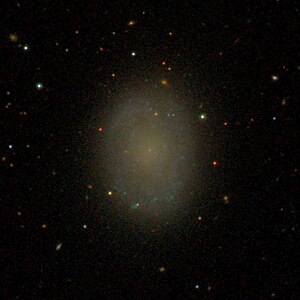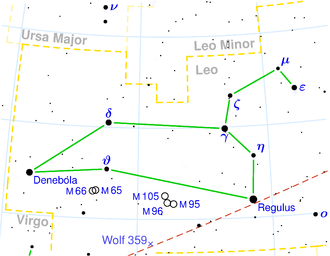NGC 3299
| Galaxy NGC 3299 |
|
|---|---|

|
|
| SDSS recording | |
| AladinLite | |
| Constellation | lion |
|
Position equinox : J2000.0 , epoch : J2000.0 |
|
| Right ascension | 10 h 36 m 23.8 s |
| declination | + 12 ° 42 ′ 27 ″ |
| Appearance | |
| Morphological type | SAB (s) dm |
| Brightness (visual) | 13.1 mag |
| Brightness (B-band) | 13.7 mag |
| Angular expansion | 2.20 × 1.7 |
| Position angle | 3 ° |
| Surface brightness | 14.4 mag / arcmin² |
| Physical data | |
| Affiliation | LGG 217 |
| Redshift | 0.002138 ± 0.000020 |
| Radial velocity | (641 ± 6) km / s |
|
Stroke distance v rad / H 0 |
(24 ± 2) x 10 6 ly (7.41 ± 0.53) Mpc |
| history | |
| discovery | William Herschel |
| Discovery date | March 19, 1784 |
| Catalog names | |
| NGC 3299 • UGC 5761 • PGC 31442 • CGCG 065-064 • MCG + 02-27-029 • 2MASX i J1036237 + 124226 • GC 2147 • H III 54 • h 726 • GALEX ASC J103623.88 + 124225.2 | |
NGC 3299 is a barred spiral galaxy of the Hubble type SBdm in the constellation Leo, north of the ecliptic . It is estimated to be 24 million light years away from the Milky Way and has a diameter of around 15,000 ly.
In the same area of the sky are the galaxies NGC 3306 and IC 619 , among others .
The object was discovered by Wilhelm Herschel on March 19, 1784 .
